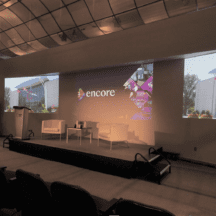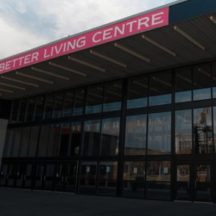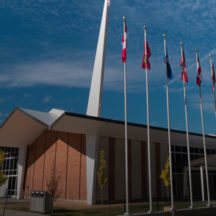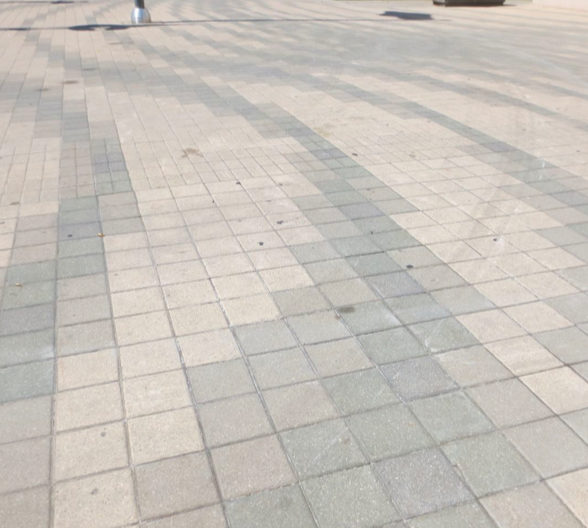
Jerry Clapsaddle
Visitors walking along the south exterior of Enercare Centre will encounter Jerry Clapsaddle’s integrated artwork, Shoreline, the precast concrete paving design that extends the length of Enercare Centre along Princes’ Boulevard.
read more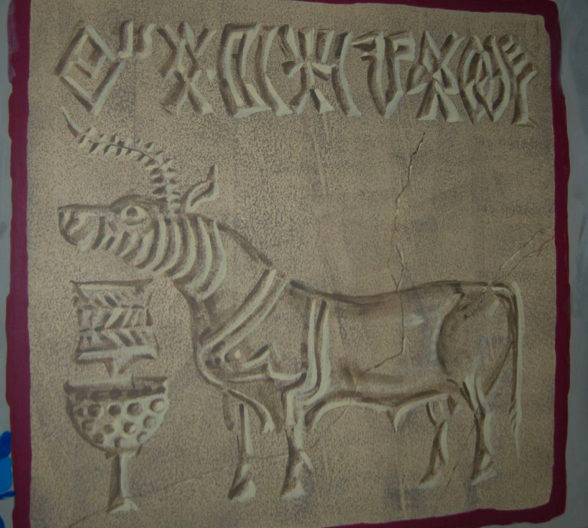
Wayne Mann
Hidden in the depths of Enercare Centre’s lower level is a long quiet tunnel filled with pictograms, symbols and text.
read more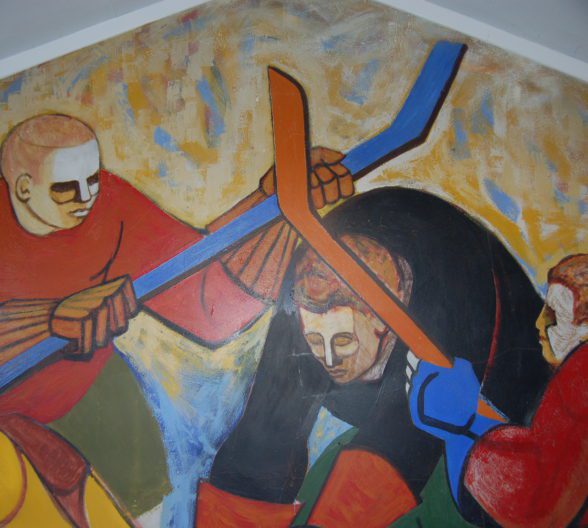
Ronald Satok
Two teams or two players facing off in the heat of competition – this moment is captured in Ron Satok’s painting inside BMO Field Gate 5 entrance.
read more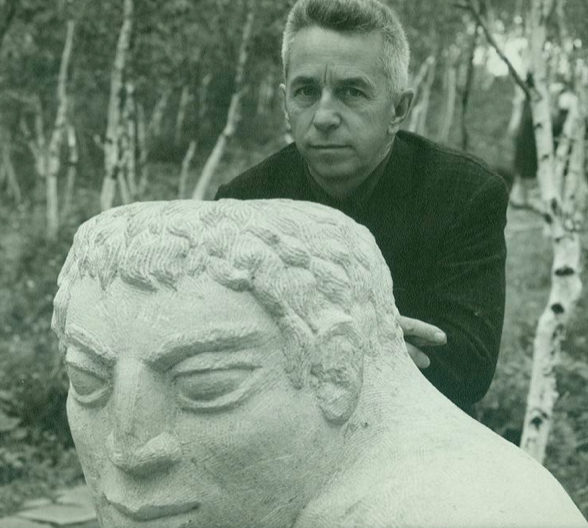
E. B. Cox
Elford Bradley (E.B.) Cox (1914-2003) is widely acknowledged as Canada’s foremost sculptor in stone.
read more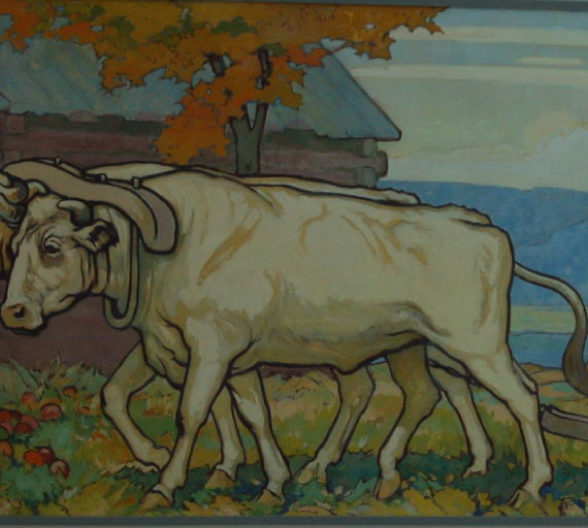
Frederick Stanley Haines
If you have ever walked along the southeast end of the Enercare galleria, looking for a quiet spot to rest, you may have noticed eight large paintings hung high on the walls.
read more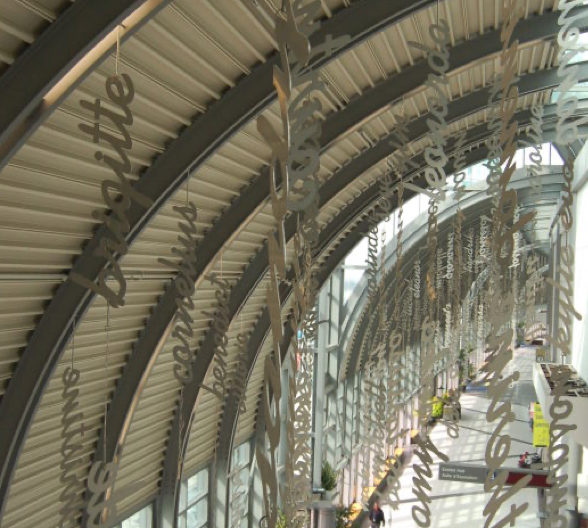
Micah Lexier
Have you ever walked along the Galleria of the Enercare Centre and found your name dangling from the rafters? It’s possible that your name is one of 1,000 names suspended from the ceiling of the Enercare Centre.
read more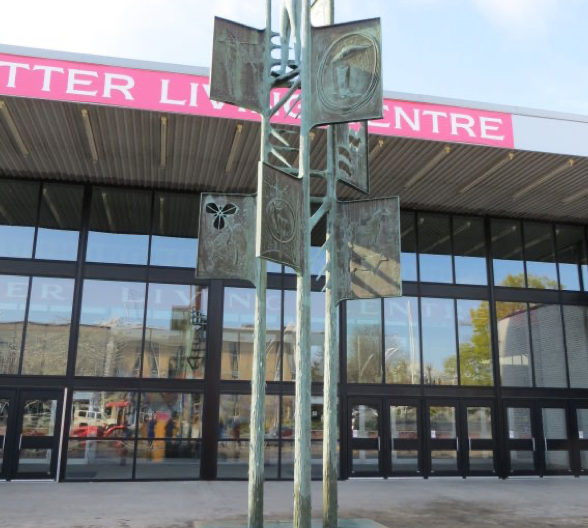
Arthur Donald Price
Just outside the north entrance of the Better Living Centre, a tall 25-foot metal sculpture with agricultural images stands in the center of the entrance square.
read more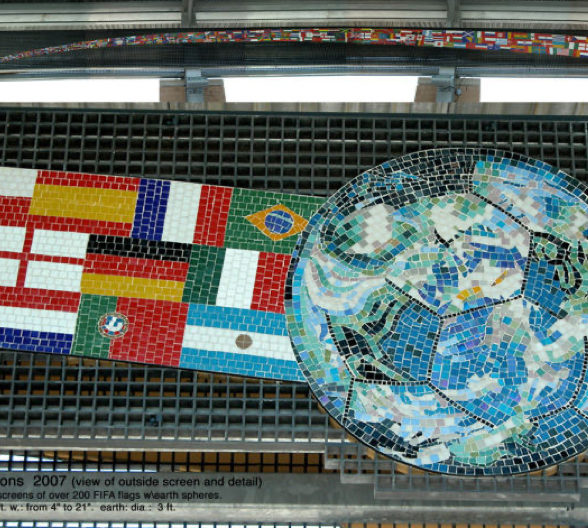
Stephen Cruise
In 2007 with the opening of the BMO Soccer Field, Exhibition Place commissioned artist Stephen Cruise to create art installations for the new facility.
read more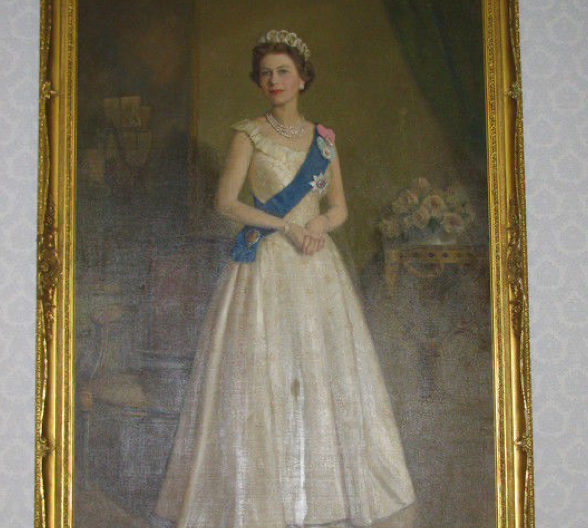
Denis Quentin Fildes
When the Queen Elizabeth Building opened in 1957, Exhibition Place acquired a portrait of HRH Queen Elizabeth II to grace its halls. The painting was done by portrait painter Denis Quentin Fildes ca. 1955.
read more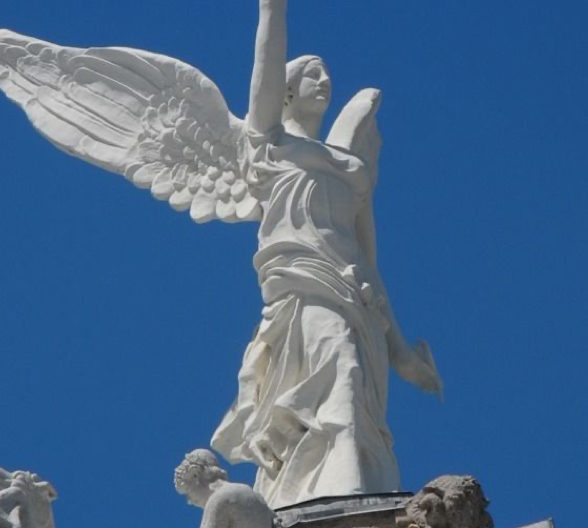
Charles McKechnie
The winged victory along with the other statuary on the Princes' Gates was created by sculptor Charles Duncan McKechnie in 1927.
read more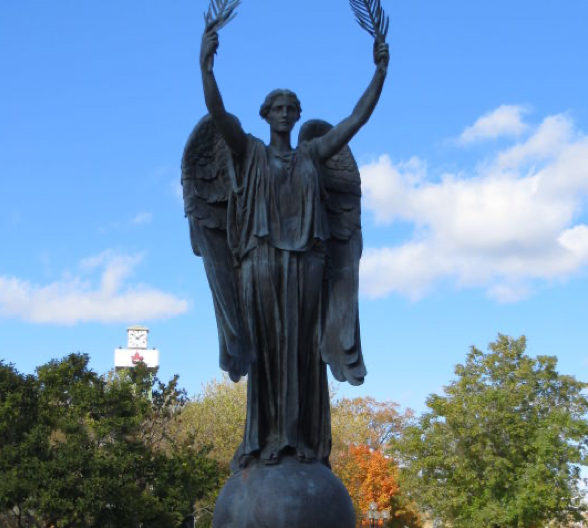
Charles Keck
The Shriners’ Peace Memorial is located in the beautiful rose garden, just south of the Bandshell. The monument was created by Charles Keck, an American sculptor, in 1930.
read more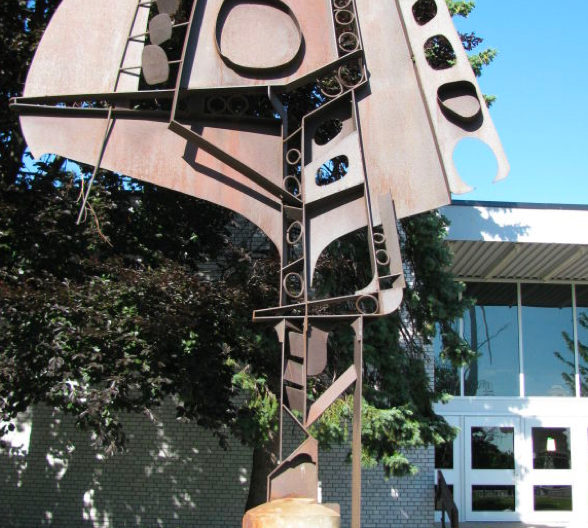
Ron Baird
The 26-foot high sculpture was originally built in front of the Art Gallery and at a later date relocated to the west side of the Better Living Centre. It is titled 83 after Seagram’s 83 Canadian Whiskey.
read more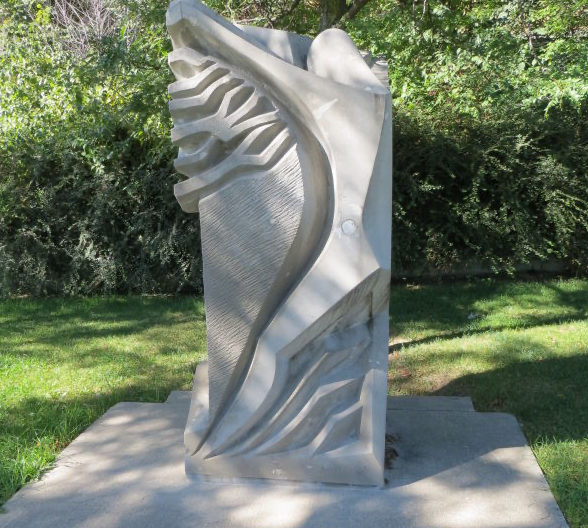
Antonis Myrodias
A group of six sculptures from the International Sculpture Symposium held during the annual Canadian National Exhibition in August of 2005 now line the northeast lawn of the Enercare Centre.
read more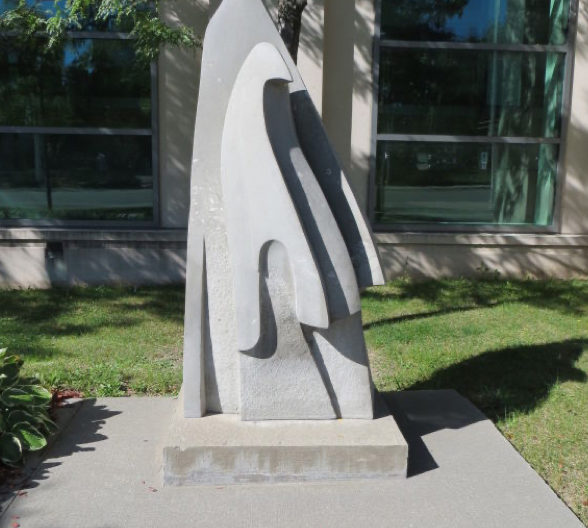
Man-Wai Wu
A group of six sculptures from the International Sculpture Symposium held during the annual Canadian National Exhibition in August of 2005 now line the northeast lawn of the Enercare Centre.
read more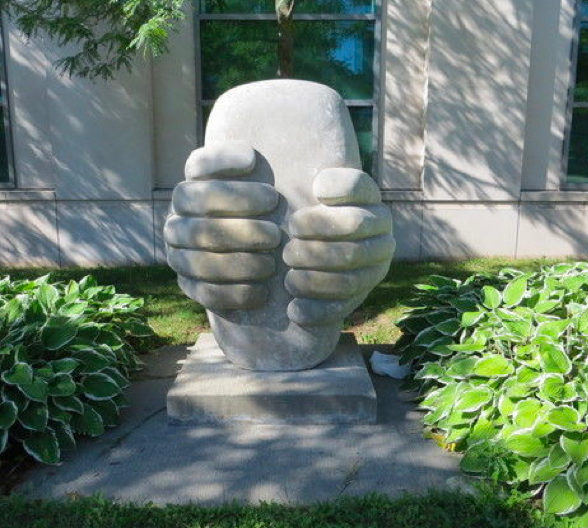
Wai-Ming Cheung
Wai-Ming Cheung from Canada was 1 of 10 artists to participate in the International Sculpture Symposium in 2005. Wai-Ming carved a set of hands grasping an object.
read more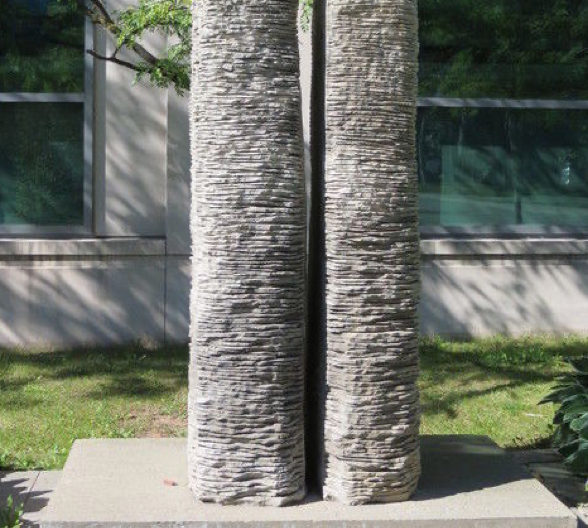
Anna Bem-Borucka
Anna carved two pillars from limestone, each one measuring 40 cm x 90 cm and 2.45 metres high, placed very close together. Each pillar has deep, closely spaced horizontal saw cuts, 1 to 3 cm apart, on its entire outside surface so that the pillar appears to be made of loose natural layers.
read more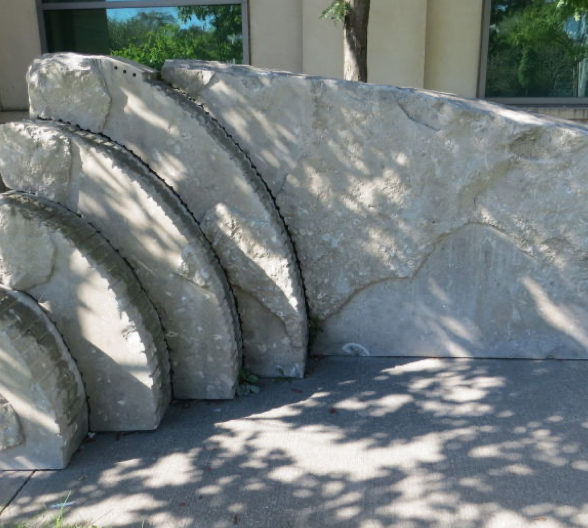
Ryszard Litwiniuk
Ryszard says of his work: “The most important elements of my work are mass, space and movement. The possibility of motion and change is my main interest, as well as its connection to the notion of touch. My works focus on the transformation and transition of forms from geometric into organic abstract objects.”
read more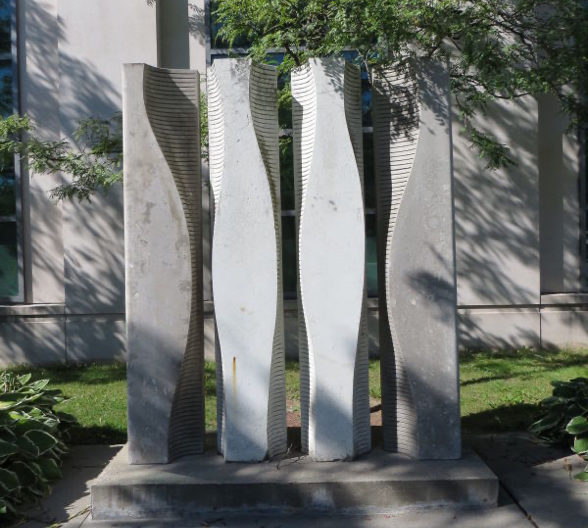
Matthias Contzen
Matthias carved four pillars from limestone, each one measuring 180 cm high and 40 cm wide and evenly spaced together. The title of the piece is Spirits of the North.
read more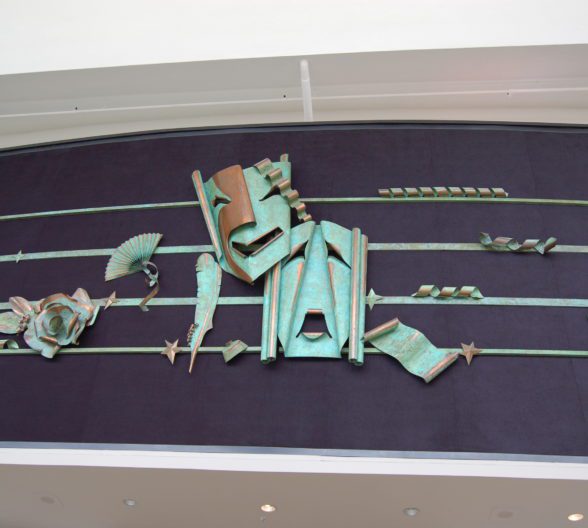
Elizabeth Wyn Wood
When the Queen Elizabeth Building opened in 1957, it boasted an impressive copper sculpture by sculptor Elizabeth Wyn Wood.
read more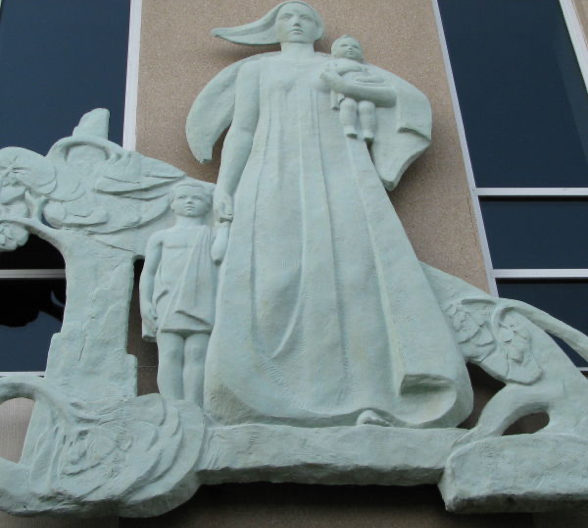
Frances Loring
In 1957, sculptor Frances Loring created a relief sculpture for the newly constructed women’s building, later named the Queen Elizabeth Building.
read more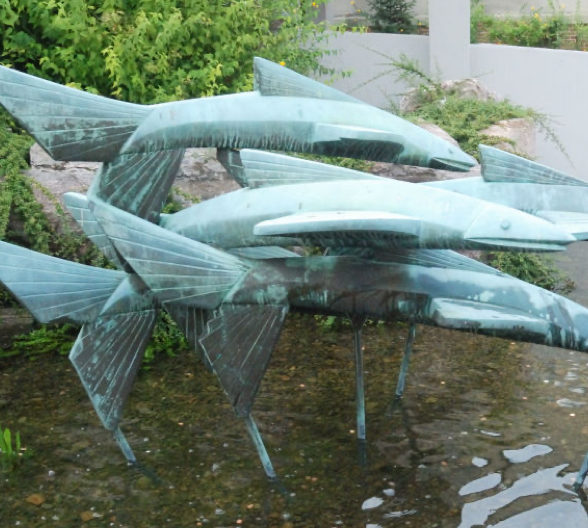
Jean Horne
Before entering the Food Building, have you ever noticed a group of fish flying in midair but no water to be seen? This lifelike bronze sculpture of five flying fish is the work of Canadian sculptor Jean Horne.
read moreJerry Clapsaddle
The artist saw his enormous “wave” as a metaphor for the lake shore and the flow of “trade” through the site, compressing and expanding dynamically.
In 1996 Jerry Clapsaddle was commissioned by Exhibition Place to create a body of public art for the newly built National Trade Centre (today known as the Enercare Centre). When the National Trade Centre opened in 1997, visitors to the centre were welcomed by a wave patterned brick entrance leading to the steps of the building.
The art advisory committee for the National Trade Centre included an art mentoring program as part of this public art commission. Jerry selected an apprentice artist from Dundas, Ontario named Brian Skol. Skol, a graduate of the Ontario College of Art and Design, created a documentary video of the project, and composed a musical piece inspired by Clapsaddle’s wave pattern in the pavers.
Jerry Clapsaddle explains his concept for the site in his public art proposal from 1995: “The flow of trade on this lakeshore has a history and energy that can be celebrated and made evident on the ground plane surrounding and supporting Exhibition Place. The work will express the dynamics of the history and activities of the site. The forces of nature, the enterprise & innovations of man meet on this shoreline.”
Shoreline was a large multi-component artwork involving installations on the south and east sides of Enercare, the north section of Beanfield and a small section of Heritage Court entrance (west Enercare). The piece consists of 135,000 individually laid paving stones at the building’s entrances, which form the public promenade adjacent to Princes’ Boulevard.
Excerpt taken from the NTC Public Art program pamphlet
Jerry Clapsaddle was born in Iowa in 1941. He attended Drake University in Iowa and later went on to study Studio Art/Graphic Design at Indiana University (Bloomington).
Jerry Clapsaddle held the position of art professor at George Mason University in Virginia from 1982 – 2005. During his career at George Mason University, Clapsaddle worked to promote the public exhibition of student and faculty art. In 1987 he founded ArtsBus, a program of the Department of Art and Visual Technology (later the School of Art) in the College of Visual and Performing Arts at George Mason University, which plans field trips for art students to galleries in New York, Philadelphia, and Richmond. The ArtsBus program continues to be part of the Arts Program at the University today.
Jerry Clapsaddle has public works of art in all parts of North America including the states of Maryland and Virginia.
Jerry Clapsaddle passed away peacefully in Florida on August 21, 2023.
Image details: Section of Shoreline by Jerry Clapsaddle, stone pavers, 1996
Wayne Mann
Universal Link is located in the underground link between Enercare Centre and the Beanfield Centre. The mural contains fifty-five different languages or symbols reflecting some of the oldest languages and civilizations in human history. The concept and design of the mural was crafted by artist Wayne Mann and executed with the help of three other artists: Ivo Stoyonov, Marie de Sousa and Victoria Bret.
In 1997 the company Kurtz Mann Inc. was commissioned by Exhibition Place to create an art installation for a new exhibition hall that later came to be known as the National Trade Centre and today is known as the Enercare Centre. Wayne Mann’s concept saw symbols and language as the topic of an abstract composition that in itself would travel through history. Communication was the key link in the development of a strong cultural bond in early cultures. Creating symbols and later the written language as a means of communication was the universal endeavor of all peoples.
The mural is a rambling pathway of abstract composition, composed of prehistory symbols and ancient alphabetical characters. The abstract mural walls are composed of symbols taken from pottery and the interior and exterior walls of ancient dwellings and monuments. The ceiling emphasizes the written language from the earliest Sumarian tablet on through ancient times, taking examples from dwellings, tablets, seals, pottery and adornments.
Wayne Mann was born in Brantford, Ontario in 1948. He studied art at the University of Windsor in Ontario and in 1974 received his Master of Fine Arts in printmaking from Tulane University in New Orleans. From 1975 to 1979 Wayne taught visual arts and lectured at the Art Gallery of Ontario. During this time he developed his painting skills in landscape, interiors and commission portraiture, which led to an Ontario Arts Council Grant to study Pre-Raphaelite painting technique with David L. Smith in London, England.
In 1980 Wayne worked part time at the CBC Scenic Art Department. The experience of working on film sets and large scale backdrops led to an interest in mural painting. That same year Wayne started an interiors’ special-painting business Kurtz Mann Inc., with Lisa Kurtz. Kurtz Mann Inc. specialized in painting and finishing techniques and materials. The firm created commissioned art, furniture and environments, executing large scale artworks in Canada, USA, Bermuda, Turkey, Portugal, Brazil and Japan. The company closed in 1999.
In 2000 Wayne began a new venture called Lining Arts Inc. Lining Arts Inc. is a multi-disciplinary artistic studio that collaborates with architects, designers and general contractors in such diverse fields as health care, hospitality and entertainment, commercial and residential projects ranging in size from a single piece of furniture to 2,600 metres square. They have worked with clients in Canada, USA, Asia, South America and Europe.
Wayne Mann on his artistic style: “Since 1980 I have been involved in custom sculpture, wall finishes, furniture and murals. Inventing special wall finishes grew out of the murals and they have expanded the palette with which I am able to work and also providing an opportunity to work with and maintain a professional staff of gifted artists with whom to collaborate. Furniture is sculpture and a painting; a painting is a surface with a special finish. In art you create a concept, image and technique (surface).”
To view the current portfolio of Wayne Mann please visit: www.liningarts.com.
Biography provided by Wayne Mann
Image details: Section of wall from Universal Link by Wayne Mann, acrylic, 1997
Ronald Satok
A Hockey painting in a Soccer Stadium? Some might question this juxtaposition but the painting Face Off is not just about hockey – it’s the epitome of so many sports.
Ron Satok was born in 1932 in Simcoe, Ontario. He received his diploma in drawing and painting from the Ontario College of Art (OCAD U) in 1954. Satok went on to complete a Master of Fine Arts at the University of Guanajato in Mexico and then a doctorate in Art and Art Education at Columbia University in New York.
Ron Satok has had a rich career in the visual arts. His work has been shown all over the world, including several shows in New York art galleries in the 1960s and 1970s. With a travel fellowship from the Ontario Arts Council in 1969, Satok painted and studied art in Japan and England. On his return to North America, he held an exhibition called Japan Series at the In Circle Gallery, a gallery he co-owned in New York City in 1971.
Ron Satok has produced several commissions in Toronto. In 1959 Satok was commissioned by Reeves and Sons (Canada) Limited to create a large mural. The Painter’s Eye is a mosaic made from Venetian glass and ceramic tiles that measures 16 feet by 7 feet and was hung on an exterior wall at Reeves. The mural was donated to Exhibition Place in 1971 and hung on the east-facing wall of the then Arts Crafts and Hobbies Building (now Medieval Times). In 2011, the Painter’s Eye was moved to the north entrance of the Better Living Centre.
After losing his eyesight in 1978, Satok founded the Satok School of the Arts, where he taught children and adults who were blind or physically or developmentally challenged to discover their innermost emotions and transpose them into art.
Ron Satok received an Order of Ontario Lifetime Achievement Award in 1994.
“When you have a calling, believe in the power of it and follow your dream.”
To view some of Ron Satok’s artworks and read more about his career please visit the Rogallery website: www.rogallery.com/Satok/Satok-biography.html.
Ron Satok passed away in 2018.
Image details: Detail from Face Off by Ron Satok, polymer tempera, 1961
E. B. Cox
His sculpture has been described as the great bridge between the native art of Canada and the modern art of the twentieth century.
Cox’s career spanned more than a half century. One guidebook says that “Cox has more sculpture on view in Toronto’s public places than any other single artist.” His monumental works – in stone, metal, wood and glass – can be seen by the public at schools, universities, government buildings, churches, libraries, banks, hotels, and parks across Toronto, and are in public places and private collections across Canada and the US.
E.B. Cox also has more works of art at Exhibition Place than any other artist. His three massive limestone bears, along with “Youth and the Environment,” are on display near the Queen Elizabeth Building. His colossal “tour de force” – the Garden of the Greek Gods – was installed at Exhibition Place in 1979, for permanent display on the south lawn of the Horticulture Building.
Cox was born in Botha, Alberta in 1914. He studied languages at the University of Toronto, supporting himself by selling small wooden carvings. It was here that he met Professor Barker Fairley, through whom he became acquainted with many other artists, including members of the Group of Seven. (Later, Cox was given the honour of carving their gravestones.)
From 1939 to 1950, Cox taught French and German at Upper Canada College (UCC). When World War II broke out, he enlisted in the Intelligence Corps, serving as a translator for three years before returning to UCC. In 1948, Cox married Elizabeth (Betty) Campbell with whom he had two daughters. In the 1950s, he gave up his teaching career and became a full-time artist.
Cox soon became active in Toronto’s gallery and art show scene, and quickly earned recognition for his work. A member of both the Ontario Society of Artists and the Sculptors Society of Canada, Cox had the first one-man show at McMichael’s Gallery in Kleinburg, Ontario. He was a self-taught artist and prided himself on achieving artistic and commercial success without ever taking a penny in government grants.
Cox was an inventor and teacher, as well as an artist. He pioneered the use of the compressed-air chisel to carve stone, a technique that enabled him to single-handedly create large-scale installations. An excellent mentor, Cox helped many younger artists as they started their careers.
He also created many hundreds of smaller sculptures that he sold to private collectors. He claimed to have invented “coffee table sculpture” – smaller pieces that were affordable by ordinary art-lovers, not just wealthy collectors, and could be displayed in the home. He was the “artist in residence” at the Royal Agricultural Winter Fair for a couple of years, carving figures in butter while the public observed.
E.B. Cox was not only one of Canada’s finest artists. He was also a very special man, and will be fondly remembered by his students, as well as his collectors, as they pass down their memories – along with their cherished Cox sculptures – to the next generation.
Biography provided by Kathy Sutton
E. B. Cox with Centaur, one of the Greek Gods
ca. 1964
Frederick Stanley Haines
These magnificent paintings, known collectively as The Settlement of Canada, were executed under the direction of artist Frederick Stanley Haines. They depict the history of exploration and trade in Canada.
Frederick S. Haines was born in Meaford, Ontario in 1879. Haines attended the Central Ontario School of Art (later to become the Ontario College of Art and Design). He was a versatile artist, equally good at portraits, figure painting (gold medal from Academie Royale des Beaux Arts in Antwerp), landscapes and animals, as well as a successful engraver and print maker. As if that were not enough, he also proved himself to be a most able educator, mentor and administrator. Haines was the president of the Ontario Society of Artists, a founding member of Canadian Society of Painters of Watercolour, a founding member of Canadian Society of Etchers and Printers, the curator of the Art Gallery of Ontario (1928-1932) and a most respected principal of the Ontario College of Art (1933-1952).
Haines was also involved in art exhibitions held at the Canadian National Exhibition in its Art Gallery (demolished in 1972) and Graphic Arts building (demolished in 1955). In 1921, Haines joined the Department of Fine Arts of the Canadian National Exhibition as the Secretary for the Graphic Arts section. He later became the CNE’s Commissioner of Fine Arts and introduced the paintings of Picasso, Salvador Dali and Matisse to CNE patrons. Haines traveled extensively for the CNE and brought the first large show of Mexican and Southwestern U.S. Arts and Crafts to Toronto. His association with the CNE lasted from 1921 to 1951.
In 1929, the Canadian National Exhibition Board of Directors recommended that Fred Haines and his assistant Herbert Palmer, together with their students, be authorized to paint four of the eight panels of the frieze of the Dominion Government Building (now Medieval Times). Under Haines’ direction and guidance, four large murals were painted for and then installed in the dome of the building. In 1930 another four murals were painted and installed to complete the eight panel frieze, The Settlement of Canada. In 1996, the paintings were removed from their original location and later re-installed in the east Galleria of the Enercare Centre.
Excerpt from the Minutes of the Meeting of the Board of Directors held June 26, 1929.
Frederick S. Haines was a contemporary and friend of the Group of Seven and was instrumental at convincing his first cousin Franklin Carmichael (from Orillia) to pursue the arts professionally. He invited Carmichael and some other members of the Group of Seven to teach at the OCA, much to the benefit of its students. Haines was instrumental in tremendously increasing student enrollment, introducing new courses of study, and establishing a much wider participation of artists in the community by promoting advertising and industrial design.
Haines’ paintings are held by the Meaford Museum, Georgian Bay Secondary School in Meaford, the National Gallery of Canada and many other public and private institutions in Canada.
Frederick Stanley Haines passed away in 1960.
Image details: The Settlement of Canada, one of eight murals by Frederick S. Haines, oil on canvas, 1929-1930
Located at the east end of the Galleria in the Enercare Centre
Micah Lexier
Next time you’re in there tilt your head back and take a look.
In 1996 Micah Lexier was commissioned by Exhibition Place to create an art installation for a new exhibition hall that later came to be known as the National Trade Centre and today is known as the Enercare Centre.
The installation, titled Hall of Names, consists of 1,000 laser-cut stainless steel names that hang in a series of chains in the 245 meter-long Galleria of the Enercare Centre in Toronto.
The art advisory committee for the National Trade Centre included an art mentoring program as part of this public art commission. Micah selected an apprentice from the Ontario College of Art and Design named Panya Clark Espinal to assist him in all aspects of the commission, including the “Call for Names” campaign and the fabrication and assembly process of the names.
Micah Lexier explains the concept behind his installation: “During the month of June 1996, I put out a call for names through the local media. From the thousands of names submitted, I randomly drew 1,000 names to be included in the work. The names were then typeset, laser-cut from 1/8″ stainless steel and joined together in chains of up to 6 names long.”
Micah Lexier was born in 1960 in Winnipeg. Micah graduated with a Masters of Fine Arts from the Nova Scotia College of Art and Design in 1984. He currently lives and works in Toronto. Micah is a multimedia artist whose many-tiered practice includes sculpture, installation, photography and text-based work, as well as curation. A well-known photographic work of Lexier’s, David: Then and Now (2005), reworks his Portrait of David (2004), spanning 10 years, and showing the effects of aging on 75 men named David, each a different age from one to 75.
A sculpture by Micah Lexier, Selections from the Synopsis of Categories, was installed at Metro Hall in 1992 and consists of 26 custom-made aluminum ladders of various heights, mounted against the walls of Metro Hall lobby on which 400 words signifying aspects of civic life and government are listed. The words were randomly selected from the “Synopsis of Categories” section of a thesaurus. Micah’s combination of ladders with words symbolizes the physical effort and ideas required to create a city. The ladders represent the many services offered by a municipal government and the words represent the policies.
Excerpt from Creating Memory: A Guide to Outdoor Public Sculpture in Toronto by John Warkentin
Micah has had more than 100 solo exhibitions, participated in some 200 group exhibitions and produced several public commissions. Micah’s work is found in various collections all over the world, including the British Museum in London, the Contemporary Art Gallery in Sydney, Australia, The National Gallery of Canada and The Art Gallery of Ontario.
Micah recently received the 2015 Governor General’s Award in Visual and Media Arts. He was one of eight Canadian artists honored.
Micah Lexier is currently represented by the gallery Birch Contemporary in Toronto. For more information on Micah and his work please visit: www.birchcontemporary.com/artist/micah-lexier
Image details: Hall of Names, stainless steel installation by Micah Lexier, 1997
Located in the west end of the Galleria in the Enercare Centre
Arthur Donald Price
This sculpture Man Above Matter, originally stood in front of the entrance to the Coliseum , but was moved to its present location prior to the construction of the National Trade Centre in 1997 (now the Enercare Centre). The sculpture was a commission done by artist Arthur Price in 1964.
Man Above Matter consists of 300 separate mold pieces which were made for casting by Price. He produced them in his studio, and then moved them to the foundry where the bronze casting was poured. Sixteen realistic objects appear in the sculpture to illustrate the events held in the Coliseum. The shape of the work is basically three poles in a triangular arrangement with banners attached to each of them. On the banners are the realistic objects representing the activities held within the Coliseum. At the top of the sculpture, on a spar joining two of the poles is a human figure with arms stretched upwards.
Reference: Canadian Coppermetals, Spring, 1964 and Foundry, June, 1964
Born in Edmonton, Alberta in 1918, Arthur Donald Price attended Western Technical School where he received a bursary to study at the Ontario College of Art and Design in the evenings, under various teachers including Franklin Carmichael and Frederick S. Haines. Naturally creative, he worked as a free-lance commercial artist, and later went on to study dance with Boris Volkoff, build sets and appear in productions. Price also studied pattern-making and industrial design. In 1943 he went to the National Film Board of Canada as a set designer and part-time animator. It was while working at the NFB that he met and married Dalila Barbeau, daughter of noted ethnologist and folklorist Dr. Marius Barbeau.
During his travels Price became acquainted with the art of the North West Coast Indians. He visited Indian villages, taking notes and photographs and making drawings of Indian art. Price arranged the purchase and removal of totem poles, house posts, a community house and other pieces which established the Indian village at the University of British Columbia in 1947.
Later, Price opened a studio near Ottawa where he was able to continue wood-carving. In 1950 he began metal work in wrought iron, copper and subsequently, sterling silver. With his considerable experience in set designing he was appointed Technical Director for the 1952 Canadian National Exhibition grandstand show in Toronto.
In 1953 he was commissioned to carve two large totem poles and three other large carvings for Jasper Park Lodge in Alberta. In 1954 he began casting in aluminum, iron and bronze. This led to his production of an impressive body of work on public sculpture commissions for government, corporations and industry.
Arthur Price was a member of the Sculptors Society of Canada (1958), the Royal Canadian Academy (Associate-1960, Member-1973), the Arts Club, Montreal (1958), and the American Craftsmen’s Council (1960).
Arthur Price experimented artistically with many mediums and art forms including woodworking, set design, metalsmithing, sculpture and painting. Throughout the course of a long, productive career Price was perhaps most recognized for his commissioned public installations displayed in the Ottawa region and across other Canadian cities.
Arthur Price passed away peacefully in Toronto, Ontario in 2008.
References: A Dictionary of Canadian Artists, volumes 1-8 by Colin S. MacDonald, and volume 9 (online only), by Anne Newlands and Judith Parker
National Gallery of Canada / Musée des beaux-arts du Canada
Image details: Man Above Matter, bronze sculpture by Arthur Price, 1964
Located at the north entrance of the Better Living Centre
Stephen Cruise
The result was 14 granite benches as well as a two-sided glass mosaic entitled Arc of Nations. The benches are scattered around the perimeters of the soccer venue and feature the artist’s designs (based on the sporting and architectural history of Exhibition Place) laser cut into the granite. Cruise’s benches proved so popular that an additional 4 were commissioned by Exhibition Place and are installed on the north and south sides of the Beanfield Centre. The Arc of Nations, located over the north entrance to the BMO Field, is approximately 54 inches in length and is comprised of over 200 tiny FIFA flags trailing like shooting stars behind an earth sphere that also resembles a soccer ball.
Stephen Cruise was born in Montreal in 1949. He attended the Ontario College of Art and Design (OCAD U) from 1967 – 1970. He has traveled around the world and lived for extended periods of time in Seoul, South Korea and Tokyo, Japan.
Stephen Cruise was a founding member of A Space in Toronto (Canada’s first artist run gallery) from 1970 to 1974. As an artist and sculptor he has been awarded grants from the Canada Council for the Arts and the Ontario Arts Council. His work is housed in the permanent collections of the National Gallery of Canada, the Art Gallery of Ontario, the University of Calgary, and the Canada Council Art Bank. Some of his public art commissions include Indigena Domain, located at Cambridge City Hall, and Vessel, located at the Manulife Recreational Centre in Waterloo, Ontario.
Cruise has won several important commissions for public art in the Toronto area. The bronze and concrete sculpture along Spadina Avenue called Uniform Measure/Stack from 1997 reinforces his interest in ideas of localized history. This particular piece embodying a sewing thimble pays tribute to Spadina Avenue’s historical fashion district.
Cruise’s sculptures have been exhibited across North America and featured in many international shows, including three recent appearances in the Bienal Barro de Americo in Caracas, Venezuela.
Stephen Cruise currently lives and works in Willowdale, Ontario. Stephen Cruise is also an accomplished martial artist in Kendo 5dan, (Japanese sword fencing) and Iaido Renshit 6dan (Japanese sword draw). To view more of Stephen’s work please visit his website: www.stephencruise.ca
Image details: Arc of Nations, glass mosaic installation by Stephen Cruise, 2007
Located above the North Entrance, BMO Field
Denis Quentin Fildes
Denis Quentin Fildes was born in Lancashire, England in 1889. Fildes joined the Royal Navy in 1906 and was a midshipman. When war was declared with Germany in 1914 Fildes was already a lieutenant with his own ship. In December of 1915 the ship blew up and sank causing great loss of life. Fildes was badly burned but survived. In March of 1916 he was back in service and continued as lieutenant on various vessels until 1922. He was then retired with a disability pension, but during the Second World War served as a port officer.
In civilian life he followed his father’s profession as a portrait painter. His father Samuel Luke Fildes (1843 – 1927) was an accomplished illustrator and painter and had been commissioned by the British Royal Palace to paint portraits of various royal members.
One of Denis Fildes’ commissions was a full-length portrait of Queen Elizabeth II and Prince Philip for the Royal Naval College at Greenwich in London. Fildes painted royal portraits of Queen Elizabeth II, the Queen Mother and King George VI. His portrait of King George VI (1895-1952) as Admiral of the Fleet (ca. 1949 – 52) is part of the Royal Collection Trust in England.
Many of his portraits are housed in museums all over England. Fildes’ sword, photographs of his naval career, letters and signals are housed in the National Maritime Museum’s collection in Greenwich, London.
Denis Quentin Fildes passed away in 1975. For more information about the artist please visit the Royal Museums Greenwich website: www.rmg.co.uk.
Lieutenant-Commander Denis Quentin Fildes, 1889-1975 painted by his father Samuel Luke Fildes (1843-1927) oil on canvas, 1912, in the National Maritime Museum in Greenwich, London
Image details: Her Majesty Queen Elizabeth II, oil on canvas by Denis Quentin Fildes ca. 1955
Located in the Records & Archives Office, General Services Building
Charles McKechnie
The winged victory on top of the Princes’ Gates is synonymous with the entrance to the Exhibition grounds. It is a favourite subject among photographers and tourists. The winged victory along with the other statuary on the Gates was created by sculptor Charles Duncan McKechnie in 1927.
Born in the county of Warwickshire, England in 1865, Charles McKechnie later crossed the pond to North America in 1904. Prior to that he had taught modelling and designing at the Birmingham School of Art. Charles studied at the Beaux-Arts school in Paris. He is best known for creating the winged victory atop the Princes’ Gates in 1927 as well as all the other statuary on the Gates.
Charles McKechnie worked very closely with Chapman and Oxley, the architects for the Princes’ Gates. The winged figure symbolizes the inspiration and determination of the past as it points the way toward the future. She is quite dynamic in pose while the other statuary seated on the pylons and standing on the pillars are static subjects. It is has been suggested that the sculpture was modeled after the Winged Victory of Samothrace, a classical Greek artifact housed in the Louvre.
Later in 1928 McKechnie was once again selected by architects Chapman and Oxley to design eight statues, comprised of two sets of four different figures for the top of the entrance to the newly constructed Electrical and Engineering Building. The Electrical and Engineering Building was erected in 1928 for the purpose of demonstrating to Canadians and to members of the British Empire the progress of hydro-electrical development and industrial activities in Ontario. Exhibits within the Electrical and Engineering Building featured the latest in electrical appliances and equipment for use in Canadian homes and industries. The statues, designed and executed by Charles McKechnie, are a tribute to industrial labour in Canada. When the Electrical and Engineering Building was demolished in 1972, the eight statues were salvaged and moved into storage. It wasn’t until 1997 that four of the statues found a new home in Heritage Court in the Enercare Centre.
Charles McKechnie also designed the statuary of the Ontario Government Building constructed in 1926 by architects Chapman and Oxley, today known as Liberty Grand. Two majestic lions are positioned on the south lawn of Liberty Grand while another two lions flank the building’s east entrance.
Charles McKechnie moved to British Columbia in the 1930s and later died from pneumonia in 1935 in Victoria, British Columbia.
Image details: Winged Victory, sculpture designed as part of the Princes’ Gates, by Charles McKechnie, 1927
Located at the east end of Exhibition Place
Charles Keck
It consists of a bronze monument set on a circular stone base. A winged figure, the Goddess of Peace, stands with her arms upraised and holds aloft two olive branches.
The figure is elevated on a globe of the world which is supported by two sphinxes and marked by a commemorative plaque. The monument was created by Charles Keck, an American sculptor, in 1930.
The Shriners’ Peace Memorial was dedicated in June 1930 during a convention of the Ancient Arabic Order of the Nobles of the Mystic Shrine (Shriners) to commemorate nearly a century of peaceful relations between Canada and the United States. The monument is located on the site where it was believed American troops landed during the War of 1812. The monument is surrounded by a fountain that was added in 1958.
A committee of the Shriner leadership commissioned Charles Keck to be the sculptor. He was a New Yorker and a fairly-well-known monumental artist. Keck, a Shriner himself from the Brooklyn’s Kismet Temple, had designed a number of public sculptures, coins, medals, and plaques in the 1920s and 1930s, including the friezes on the Bronx New York county building, and the Liberty Statue in Rio de Janeiro. His design for the peace monument took the form of an angel, positioned to face the Niagara River, with arms raised bearing olive branches.
Charles Keck was born in New York in 1875. He studied at the National Academy of Design and the Art Students League of New York. Keck also attended the American Academy in Rome. In 1921 he was elected into the National Academy of Design as an Associate member and became a full Academician in 1928. As a member of the National Sculpture Society, he was part of a movement of conservative American artists, many of whom worked in the French Beaux Arts style.
In a long and active career, Keck produced many sculptures and architectural reliefs, now on view from New York to Argentina. Working out of a New York City studio, he created several heroic statues of Abraham Lincoln; an equestrian statue of Stonewall Jackson now in Charlottesville, Virginia; and various busts and statues of politicians, generals, and other notable individuals.
His Lewis and Clark group, also in Charlottesville, is considered one of his greatest monuments. The National Statuary Hall Collection in the U. S. Capitol contains his bust of Harry S. Truman, Keck’s full-length statues of North Carolina’s Charles B. Aycock and Louisiana’s Huey P. Long.
Charles Keck passed away in 1951.
Image details: The Shriners’ Peace Memorial, cast bronze sculpture by Charles Keck, 1930
Located in the Rose Garden just south of the Bandshell
Ron Baird
If you have ever taken a stroll in the west end of the grounds alongside the Better Living Centre, then you may have noticed a tall metal sculpture. The sculpture was built on site by sculptor Ron Baird who was commissioned by the House of Seagram for the 1968 CNE.
Born in Toronto, Ontario in 1940, Ron Baird graduated from the Ontario College of Art and Design in 1964. He has been regularly commissioned to create large-scale, site-specific sculpture installations across Canada and abroad for more than 40 years. A sculptor and graphic artist, he is best known for his abstract sculptures. Often his work has imaginative elements that move in the wind, are light-responsive or make sounds. Some pieces also include electronics, electronic sound, interactive elements or incorporate programmed light sources.
Ron has completed more than 150 public, corporate and private commissions with a variety of inventive concepts. These include fountains, sculptural landmarks for world fairs and civic parks, towers, murals, carillons and site-specific pieces for business, donor recognition, industry government and private collectors. A lot of his projects are executed in stainless steel a medium he loves for its “versatility, permanence, and when polished, its chameleon like ability to take on the changing colours that surround it.”
Ron has taught at the University of Toronto’s Faculty of Architecture, Landscape and Design, and is a winner of numerous awards and medals including allied arts awards from both The Royal Architectural Institute of Canada and the Ontario Association of Architects for his work. Ron is also a member of the Royal Canadian Academy of the Arts.
Ron’s reflection on creating the sculpture at the CNE in 1968:
“At the time there was a wonderful Art gallery on the CNE grounds, circa 1927, neo-classical. I think it still stands. Carved into its frieze are the names of the greatest artists of all time (as imagined by the Toronto establishment back then). It was on the front lawn of this edifice that the sculpture was built and sited. The agreement was that I had to fabricate and erect the work during the CNE as a sort of performing artist…not unlike the guy who carved a thousand pounds of butter in the Coliseum. It was a difficult project to execute outside of the studio because I had only hand tools. I recall running low on concrete while casting the base and in desperation adding those big takeout drink containers from a stand nearby to the mix to take up space. For sure, the takeout containers were sturdier in those days. I suppose the title has to do with Seagram’s. Sometime later the work was moved to the Better Living Building…I don’t know why, I wasn’t consulted. The budget I’m sure was under $1,000, the material; mild steel. I believe that there was an article in the Toronto Star or perhaps The Telegram.”
For more information on Ron Baird please visit the artist’s website: Ron Baird
Image details: 83, steel sculpture by Ron Baird, built on site during the 1968 CNE.
Located on the west side of the Better Living Centre
Antonis Myrodias
The theme for the artistic creation for the symposium was: “Personal experience with nature in the context of Canada’s natural environment and its geographical position.” The objective of the symposium was to initiate artistic and cultural co-operation between sculptors of different background.
Antonis Myrodias from Greece was 1 of 10 artists to participate in the Symposium. For his piece, Antonis took a block of limestone and carved a human-like figure with outstretched arms embracing nature.
Antonis Myrodias was born in 1963 in Athens, Greece. He studied at the Atelier of Sculpture in Athens, Greece as well as studying painting in Florence, Italy. Antonis studied oil painting technique and Byzantine painting as well as the conservation of archaeological material and works of art. He also studied Architecture of the Landscape with environmental approaches and the environmental effects. Antonis conducted research at museum and archeological sites and performed conservation of prehistoric archaeological artifacts and wall paintings as well as illustrating several art books and manuscripts.
Antonis has also been recognized as a renowned sculptor both nationally and internationally. He won a gold medal at the Olympic Landscape Sculpture Design Competition, organized by the Beijing Organizing Committee of Olympic Games in 2008. The plan by the Beijing Olympiad was to create a large Olympic Open-Air Sculpture Park, next to the Olympic Village. In the end, 50 sculptures were selected by the general public together with a panel of critics. Antonis Myrodias won the golden prize for his work “Visioning 5 Nikes”. His sculpture was inspired by the ideas of Olympism, as required by the competition, but was made with a modern perception. The works of the 29 finalists were reproduced in large size and exhibited at the Beijing Olympic Forest Park located just north of Beijing.
Antonis has participated in many exhibitions and symposiums across Europe, Asia and North America. Most recently he took part in the 1st International Pergamon Stone Sculpture Symposium in Turkey in the summer of 2012. Pergamon was an ancient Greek city with remains of its ancient acropolis still intact today.
Antonis currently lives and works in Athens.
Image details: Untitled, limestone sculpture by Antonis Myrodias, created in 2005 as part of the International Sculpture Symposium held at the CNE.
Located on the east lawn of the Enercare Centre
Man-Wai Wu
The theme for the artistic creation for the symposium was: “Personal experience with nature in the context of Canada’s natural environment and its geographical position.” The objective of the symposium was to initiate artistic and cultural co-operation between sculptors of different background.
Man-Wai Wu from Canada was 1 of 10 artists to participate in the Symposium. Man-Wai carved a curved figure from limestone titled Freedom 2005. It is 213 cm high. The artist says of his work: “What I think, I see, I say, I search and love stones.”
Man-Wai Wu was born in Guangdong, China and then settled in Hong Kong in 1958. He started painting in 1969 and later completed an extension course in basic 3-dimensional design workshop at the Hong Kong Polytechnic. In 1989 he was awarded the Hong Kong Urban Council Fine Arts Award (Sculpture). Man-Wai was recognized by the Hong Kong Museum of Art with the Urban Council Fine Art Award in the Urban Council Sculpture Design Competition in 1994 (Category I & II, Hong Kong City Hall and Salisbury Garden Hong Kong).
In 1995, Man-Wai won the full Free Man Fellowship to exchange experience in the United States and worked in the Vermont Studio Center in 1996. His works were selected by the Hong Kong Museum of Art – Hong Kong Artists Series Exhibitions’ in 1995. Man-Wai immigrated to Canada in 1998 and has been working here ever since. In 2004 he won the chance to represent Canada to join the “International Stone Sculpture Symposium” hosted by ECHO research Institute. From 2005-2007, Man-Wai won several awards from painting exhibitions in the United States.
Man-Wai Wu has participated in exhibitions and symposiums across Asia and North America. He is an accomplished painter, sculptor and art instructor.
For more information on Man-Wai Wu’s work please visit the artist’s web page: Man-Wai Wu.
Image details: Freedom 2005, limestone sculpture by Man-Wai Wu, created in 2005 as part of the International Sculpture Symposium held at the CNE.
Located on the east lawn of the Enercare Centre
Wai-Ming Cheung
A group of six sculptures from the International Sculpture Symposium held during the annual Canadian National Exhibition in August of 2005 now line the northeast lawn of the Enercare Centre. The theme for the artistic creation for the symposium was: “Personal experience with nature in the context of Canada’s natural environment and its geographical position.” The objective of the symposium was to initiate artistic and cultural co-operation between sculptors of different background.
Wai-Ming Cheung from Canada was 1 of 10 artists to participate in the Symposium. Wai-Ming carved a set of hands grasping an object. Themes of Wai-Ming’s art works often relate to human relationships and reveal a diary of his experiences. While attempting to portray the thoughts, emotions and passions of modern-day people, he creatively applies a simplified pattern of a typical decorative relief used in ancient Chinese bronze vessels.
Wai-Ming Cheung was born in 1953 in Hong Kong. Wai-Ming graduated from the National Taiwan Normal University in Taipei, Taiwan and returned to Hong Kong in 1981. He taught at the First Institute of Art & Design in Hong Kong in 1983. His work was selected for the Contemporary Hong Kong Art Biennial Exhibition in 1987.
Wai-Ming was active in the 1980s, working with media such as wood and bronze in a modern style. He became known for his thought-provoking pieces that posed questions about Chinese modernity and its cultural heritage.
Sculptor Wai-Ming Cheung’s work has been shown in Taiwan, Hong Kong, China and Canada. A milestone in Wai-Ming’s career took place in 1991 with the installation of his three-metre high, bronze sculpture, Embrace Tradition, overlooking Victoria Harbour at Hong Kong’s Museum of Art.
Wai-Ming immigrated to Canada in 1991 and currently lives in Southern Ontario. The artist works in pottery and sculpture.
Image details: Untitled, limestone sculpture by Wai-Ming Cheung, created in 2005 as part of the International Sculpture Symposium held at the CNE.
Located on the east lawn of the Enercare Centre
Anna Bem-Borucka
A group of six sculptures from the International Sculpture Symposium held during the annual Canadian National Exhibition in August of 2005 now line the northeast lawn of the Enercare Centre. The theme for the artistic creation for the symposium was: “Personal experience with nature in the context of Canada’s natural environment and its geographical position.” The objective of the symposium was to initiate artistic and cultural co-operation between sculptors of different background.
Anna Bem-Borucka from Poland was 1 of 10 artists to participate in the Symposium. Anna carved two pillars from limestone, each one measuring 40 cm x 90 cm and 2.45 metres high, placed very close together. Each pillar has deep, closely spaced horizontal saw cuts, 1 to 3 cm apart, on its entire outside surface so that the pillar appears to be made of loose natural layers.
Born in 1955 in Sopot, Poland, Anna studied sculpture at the Academy of Fine Arts in Gdansk, Poland from 1975-1980. Since 1990 she has been a lecturer at the Department of Sculpture at the same university. In 1994, Anna led the Laboratory of Sculpture at the Faculty of Architecture and Design at the Academy of Fine Arts in Gdansk. Since 2008 she has worked in the Interdepartmental Studies Institute of the Arts. It deals with sculpture, drawing and photography. She has participated in numerous exhibitions and symposiums in Poland and abroad (France, Tunisia, Morocco, Russia, Georgia, Armenia, Italy, Spain, Netherlands, Belgium, Canada, Germany, Greece and Sweden).
Her work in stone has been described as “. . . a clear clash between two basic elements: the intellectual and the sensual side hidden in the human nature . . . she tames the nature of the stone, without violating it, only by discreetly adding new meanings and values, enhancing its sensual vitality and – at the same time – mysticism and spirituality . . . “J. Kamrowski (Custodian of Archaeological Museum, Poland).
Currently Anna Bem-Borucka is a professor at the Academy of Fine Arts in Gdansk, Poland – Inter-Faculty Department of Art History and Art Theory. The work of Anna Bem-Borucki is held in private collections and museums in such countries as Poland, Germany, Italy, Belgium, the Netherlands, Sweden and France.
Image details: Untitled, limestone sculpture by Anna Bem-Borucka, created in 2005 as part of the International Sculpture Symposium held at the CNE.
Located on the east lawn of the Enercare Centre
Ryszard Litwiniuk
A group of six sculptures from the International Sculpture Symposium held during the annual Canadian National Exhibition in August of 2005 now line the northeast lawn of the Enercare Centre. The theme for the artistic creation for the symposium was: “Personal experience with nature in the context of Canada’s natural environment and its geographical position.” The objective of the symposium was to initiate artistic and cultural co-operation between sculptors of different background.
Ryszard Litwiniuk from Canada was 1 of 10 artists to participate in the Symposium. Ryszard carved a large rectangle shape with cascading arcs from limestone. Ryszard says of his work: “The most important elements of my work are mass, space and movement. The possibility of motion and change is my main interest, as well as its connection to the notion of touch. My works focus on the transformation and transition of forms from geometric into organic abstract objects.”
Ryszard Litwiniuk was born in 1966 in Olsztyn, Poland. He received his Masters Degree of Fine Arts in 1992 from the Academy of Fine Arts in Gdansk, Poland, and has been involved in thirty-six international symposiums and projects throughout Europe, the Americas, and Asia. In 1998 Ryszard moved to southern Ontario where he currently works. His preferred material to work with is wood. His signature sculpting style, characterized by dynamic geometrical shapes, has been honoured by many Canadian art establishments, including eleven solo exhibitions across Ontario at the Art Gallery of Mississauga, Hart House’s Justine M. Barnicke Gallery, and the Art Gallery of Peel in Brampton, to name a few.
Most recently in the summer of 2011 Ryszard took part in the Artists-in-Residence program at the McMichael Gallery in Kleinburg, Ontario. During his month-long residency at the McMichael, Ryszard created wood sculptures for outdoor display at the gallery, utilizing recycled ash and pine planks.
His sculptures can be found in public places such as the Tree Museum in Gravenhurst, Ontario. There, Ryszard Litwiniuk transformed a discarded tree trunk scavenged from a natural-waste dump, giving new life and meaning to the wood by cutting the centre free. “My way of working in wood is to help the wood to be open. I am exploring this material as a natural tissue, and a source of energy. I want to uncover something important that is hidden inside.”
Image details: Untitled, limestone sculpture by Ryszard Litwiniuk, created in 2005 as part of the International Sculpture Symposium held at the CNE.
Located on the east lawn of the Enercare Centre
Matthias Contzen
A group of six sculptures from the International Sculpture Symposium held during the annual Canadian National Exhibition in August of 2005 now line the northeast lawn of the Enercare Centre. The theme for the artistic creation for the symposium was: “Personal experience with nature in the context of Canada’s natural environment and its geographical position.” The objective of the symposium was to initiate artistic and cultural co-operation between sculptors of different background.
Matthias Contzen from Portugal was 1 of 10 artists to participate in the Symposium. Matthias carved four pillars from limestone, each one measuring 180 cm high and 40 cm wide and evenly spaced together. The title of the piece is Spirits of the North. Each pillar is stylized with identical curves carved into the stone. “I would like to introduce my sculpture not as objects which would be perceived first time by the observer, but as prompts for a dialogue. The observer should be given a mystery to solve: his/her curiosity and imagination will help lead him/her to a new and sometimes completely subjective meaning. That who gets involved in this dialogue becomes part of the creative process . . .”
Matthias Contzen was born in 1964 in Aschaffenburg, Germany. He graduated from the European Academy of Fine Arts in Trier sculpture course in 1987 and held his first exhibition in the same year. He subsequently completed an apprenticeship in sculpture in Munich, studied design in Saarbruecken and in 1998 completed his studies at the Master School of Stone Sculpture in Mayen. In the same year Matthias left Germany to live in Portugal where he works as a sculptor.
In 2002 he was awarded the prestigious ‘Premio City Desk’ prize for sculptors. He has staged 11 solo exhibitions and participated in about 50 joint exhibitions and various art fairs. In 2007 Matthias became one of the founders of today’s SCULPTURE.FACTORY in Sintra, Portugal.
His sculptures can be found in public places such as Germany, Portugal, Canada, Spain and Dubai as well as in privately commissioned collections in Portugal, Spain, Brazil, Germany, France, Belgium, Canada, England, Sweden and New York. At present his works are represented at the Galeria Sao Mamede (one of the oldest and renowned Galleries in Portugal).
Matthias says of his work: “Rather than viewing my works passively, I like people to interact with them, the observer should be given a mystery to solve, have their imagination and curiosity stimulated, leading them to a new and often subjective, meaning”.
For more information on Matthias Contzen and his work please visit: http://www.matthiascontzen.com/index.php/c-v
Image details: Spirits of the North, limestone sculpture by Matthias Contzen, created in 2005 as part of the International Sculpture Symposium held at the CNE.
Located on the east lawn of the Enercare Centre
Elizabeth Wyn Wood
The artist had been commissioned to create a sculpture for the entrance of the new theatre inside the building. Inspired by the theatre arts Wood created a sculpture depicting the many phases for which the theatre could be used. Symbolizing most of the arts of the modern theatre, Wood created the rose and fan that suggest romance, while the ballet figures symbolized the dance. Flanking the traditional masks of comedy and tragedy are the old time playwright’s tools – quill, ink-pot and parchment. At far right a lyre and cello represent music. To make the copper sculpture look “aged”, the copper was given a chemical treatment that produced an antique patina.
Born in Orillia, Ontario in 1903, Wood attended the Ontario College of Art (now the OCAD University). Wood graduated in 1925 after four years at the Ontario College of Art, where she studied drawing, painting, and stagecraft with Arthur Lismer, commercial design and calligraphy with J.E.H. MacDonald, and sculpture with Emanuel Hahn. In September 1926, following her post-graduate year at OCA, she and Emanuel Hahn married. Beginning in November of that year, she spent two months at New York’s Art Students League, studying with Robert Laurent and Edward McCarton. She was drawn to the art and design of ancient Egypt, whose simplicity and formalized nobility characterized all of Wood’s work.
“Sculptural form is not the imitation of natural form any more than poetry is the imitation of natural conversation . . . While a piece of sculpture may contain visual forms with which we are acquainted by daily experience, it is essentially a design worked out by means of the juxtaposition of masses in space, just as poetry is a design wrought by the sounds of words in time.” (Elizabeth Wyn Wood, 1935)
Wood explored the aesthetic properties and potential of different materials and techniques as they applied to sculpture. While she did explore landscape in her work, the human figure remained the basis for her work. Some of her public commissions include the Welland-Crowland War Memorial 1934-39, the King George VI Monument (Niagara Falls, 1955-61), and the Simcoe Monument (Niagara-on-the-Lake, 1951-53).
In 1928 Elizabeth Wyn Wood along with Frances Loring, Florence Wyle, Emanuel Hahn, Henri Hebert, and Alfred Laliberte founded the Sculptors Society of Canada. By bonding together they were able to focus on the development of sculpture while raising the profile of Canadian sculpture locally and internationally.
Elizabeth passed away in Toronto, Ontario in 1966.
Image details: Theatre Mural, copper sculpture by Elizabeth Wyn Wood, 1957
Located in the foyer entrance to the Queen Elizabeth Theatre, Queen Elizabeth Building
Frances Loring
The relief sculpture was cast in polystyrene, a relatively new plastic material at the time which proved to be more permanent and weather resistant than bronze.
Born in Wardner, Idaho in 1887, Frances Loring studied art in her native United States, as well as in many European cities, before settling in Canada in 1912. Her decision to move to Toronto was motivated, in part, by a desire to participate in the artistic development of a young country. Loring achieved this goal and many others throughout her illustrious career.
While at the Art Institute of Chicago in 1905, she met lifetime companion Florence Wyle, with whom she subsequently shared studios in New York (1909–1912) and Toronto (1912–1966).
Affectionately called “The Girls,” Frances Loring and Florence Wyle were also known as the first women of Canadian sculpture. Spanning more than 50 years, their careers as sculptors have given Canadians a rich body of work that may be discovered and admired in many public spaces and galleries throughout the country.
By 1902, Loring was a member of both the Royal Canadian Academy and the Ontario Society of Artists. She was a founding member (1928) and subsequently president (1940s) of the Sculptors’ Society of Canada. Later she was involved in the organization of the Federation of Canadian Artists (1941) and the Canada Council (1950s).
Loring and Wyle’s influence on Canadian art and artists has been significant. They challenged the establishment by setting forth to prove that sculpture was as important an art form as any other, and they succeeded amidst adverse conditions.
At the turn of the 20th century, sculpture in Canada was still very much considered a curiosity, rather than an admired art form. The lack of patrons, the serious shortage of foundries and the relatively high cost of materials were all factors contributing to an inauspicious environment for sculptors. In addition, these artists had to rely heavily on commissions as a source of revenue.
Influenced by her training in the neo-classical tradition and by her exposure to a newer vision epitomized by the French sculptor Auguste Rodin, Loring’s work has a dynamic quality and a unique heroic style. She quickly became known as an outstanding architectural sculptor and was recognized for her numerous public monuments. One of her favourite works was The Queen Elizabeth Monument, originally located at the eastern entrance of the Queen Elizabeth Highway in Toronto (now located in Gzowski Park, Toronto). Loring’s heroic style can also be admired in the many war memorials she designed following the First World War. Her last commissioned piece was a statue of former Canadian Prime Minister Robert Borden, erected on Parliament Hill, in Ottawa, in 1957.
Loring was devoted to her own work, but she was also concerned with the general plight and common problems of her colleagues. Together with Florence Wyle, she lobbied diligently for recognition and created a climate that made sculpture accessible for others. Frances Loring died in Newmarket, Ontario in 1968.
Image details: Mother & Children, Relief Sculpture (Polystyrene), 1957
Located on the south façade of the Queen Elizabeth Building
Jean Horne
In fact, there are two sets of these bronze fish, one at the west entrance and one at the south entrance of the Food Building. Originally, both sets of fish were part of a system of pools and waterfalls on the exterior of the Food Building. Jean Horne was commissioned to create the sculptures for the newly constructed Food Building in 1954.
Born Jean Mildred Harris September 19, 1914 in East York, Ontario, she grew up on Broadview Avenue in the part of Toronto known as The Danforth. Jean attended the Ontario College of Art (now the OCAD University) where she studied sculpture under Emanuel Hahn. While at the Ontario College of Art, Jean helped Hahn on the Adam Beck Memorial on University Avenue, and on a figurative memorial in Mount Pleasant Cemetery. She met her husband, Cleeve Horne, at the Ontario College of Art, and they were married on February 11, 1939. Cleeve was a renowned Canadian portrait artist and sculptor. They spent their time at their home on Balmoral Avenue in Toronto, at their country home in Pickering and at their cottage in Muskoka. The cottage was designed and built by Jean and Cleeve between 1938 and 1946. They created two studios in their Toronto home, a painting studio and sculpture studio.
Jean only created a few public works. The majority of her sculpture was done for private sale. She exhibited her work at the Royal Canadian Academy, Ontario Society of Artists, Sculpture Society of Canada, and the Art Gallery of Toronto (now the Art Gallery of Ontario). Jean’s sculptures received mention in various newspaper articles over the years. Although Jean did not create many public pieces she did assist in quite a number of Cleeve’s commissioned sculptures: Alexander Graham Bell Memorial, Osgoode Hall War Memorial, Nova Scotia Coat of Arms, among others.
Jean was the first female artist in Canada to use steel welding in sculpture as a part of her body of work. In 1961 Jean’s steel sculpture entitled Beggar of Fez (1955) was shown at the CNE Art Gallery. In 1962 Jean was commissioned to create a sculpture for the new CIBC Bank in Montreal. Her steel sculpture entitled Conference, still stands in the main Banking Hall today.
Her artwork is represented at the Robert McLaughlin Gallery in Oshawa and the Agnes Etherington Art Centre in Kingston. Jean was also a member of the Toronto Arts and Letters Club, the Royal Canadian Academy of Arts and the Ontario Society of Artists. Jean and Cleeve travelled extensively around the world visiting Japan, Thailand, Cambodia, Australia, South America, Europe, Africa, and the Caribbean through numerous trips between the 1930s and 1970s. She was also an avid sailor winning numerous awards in competitions with her Aykroyd cedar strip sailboat.
Jean passed away at her home in Toronto on December 9, 2007.
Image details: Fish, Bronze Sculpture, 1954 by Jean Horne
Located at the west entrance of the Food Building

























